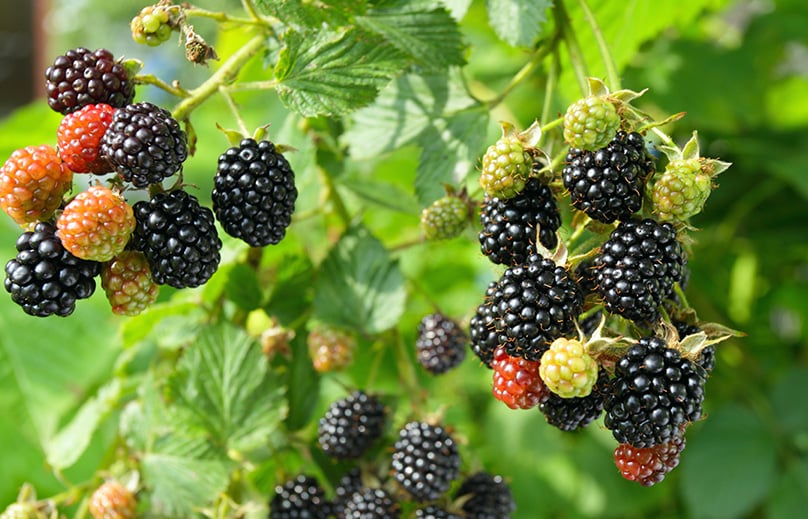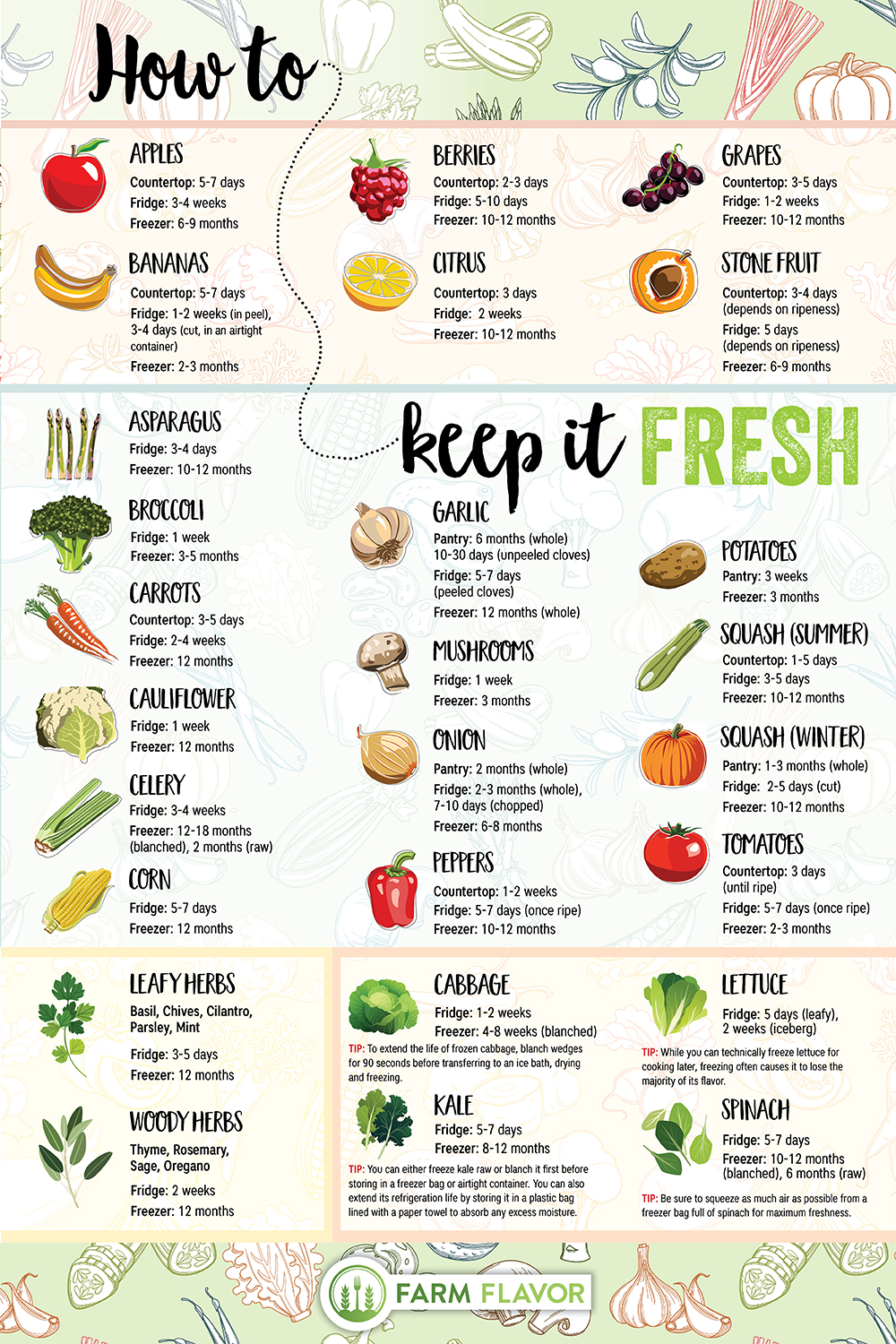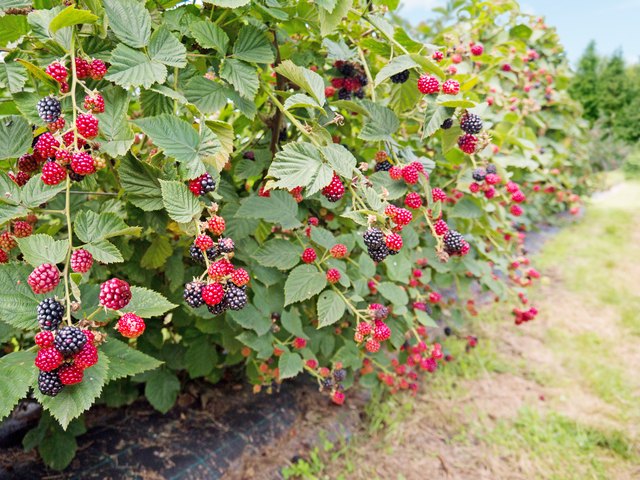Understanding Blackberry Plant Development
Blackberry plants undergo a series of growth stages, from planting to maturity, which can take anywhere from 60 to 120 days, depending on factors such as climate, soil quality, and watering. The life cycle of blackberry plants can be divided into several distinct phases, including germination, seedling establishment, vegetative growth, flowering, and fruiting.
During the germination phase, which typically lasts 7-14 days, blackberry seeds sprout and develop their first set of leaves. The seedling establishment phase, which follows, is critical for the development of a strong root system and can take up to 30 days. Once established, blackberry plants enter the vegetative growth phase, during which they produce new leaves, stems, and roots.
The flowering phase, which usually occurs 60-90 days after planting, marks the beginning of the reproductive cycle. Blackberry plants produce white or pink flowers, which are self-pollinating, but may also be pollinated by bees and other insects. The fruiting phase, which follows, can take anywhere from 30 to 60 days, depending on the variety and growing conditions.
Factors such as climate, soil quality, and watering can significantly impact the growth rate of blackberry plants. For example, blackberry plants grown in warmer climates with well-draining soil and adequate moisture may produce fruit faster than those grown in cooler climates with poor soil quality. Understanding the life cycle of blackberry plants and the factors that influence growth rate is essential for optimizing growing conditions and maximizing yields.
By recognizing the different stages of growth and development, growers can provide targeted care and support to their blackberry plants, from pruning and training to fertilization and pest management. This knowledge can also help growers anticipate and prepare for potential challenges, such as pests, diseases, and nutrient deficiencies, which can impact plant health and productivity.
How to Create Optimal Growing Conditions for Blackberries
Creating an ideal environment for blackberry plants to thrive is crucial for maximizing yields and promoting healthy growth. One of the most important factors to consider is choosing the right variety of blackberry plant. With over 200 varieties to choose from, selecting a variety that is well-suited to your climate and growing conditions is essential.
When selecting a variety, consider factors such as chill hours, disease resistance, and fruit size. Chill hours refer to the amount of time a blackberry plant needs to spend in temperatures between 32°F and 45°F to break dormancy. Varieties with lower chill hour requirements are better suited to warmer climates, while those with higher chill hour requirements are better suited to cooler climates.
Preparing the soil is also critical for creating optimal growing conditions. Blackberry plants prefer well-draining, rich soil with a pH between 5.5 and 6.5. Test your soil to determine its pH and nutrient levels, and amend it as necessary. Add organic matter such as compost or manure to improve soil fertility and drainage.
Adequate sunlight and water are also essential for healthy growth. Blackberry plants require full sun to produce well, so choose a location that receives at least 6 hours of direct sunlight per day. Water plants regularly, providing about 1 inch of water per week. Avoid overwatering, which can lead to root rot and other problems.
In addition to these factors, consider using mulch to retain moisture and suppress weeds. Organic mulch such as straw or wood chips can help to regulate soil temperature and prevent soil-borne diseases.
By choosing the right variety, preparing the soil, and providing adequate sunlight and water, you can create an ideal environment for your blackberry plants to thrive. This will help to promote healthy growth, maximize yields, and ensure a bountiful harvest. Whether you’re a seasoned gardener or just starting out, following these tips will help you to grow delicious and healthy blackberries.
The Importance of Pruning and Training Blackberry Plants
Pruning and training are essential components of blackberry plant care, playing a critical role in promoting healthy growth, maximizing yields, and maintaining plant structure. Pruning involves the removal of select branches and stems to control plant size, promote fruiting, and remove diseased or damaged tissue.
There are several types of pruning that can be performed on blackberry plants, including tip pruning, lateral pruning, and renewal pruning. Tip pruning involves removing the tips of new canes to encourage branching and promote fruiting. Lateral pruning involves removing select lateral branches to control plant size and promote air circulation. Renewal pruning involves removing entire canes to rejuvenate the plant and promote new growth.
Training blackberry plants is also crucial for maximizing yields and maintaining plant structure. Blackberry plants can be trained using a variety of methods, including the use of trellises, stakes, and mounds. Trellises provide support for the canes, keeping them upright and promoting better air circulation. Stakes provide additional support for the canes, helping to maintain plant structure and promote fruiting. Mounds provide a raised bed for the plants, improving drainage and promoting healthy root growth.
Pruning and training should be performed at different stages of plant development. During the first year after planting, pruning should be minimal, focusing on removing any dead or damaged tissue. In subsequent years, pruning can be more extensive, focusing on promoting fruiting and controlling plant size. Training should be performed throughout the growing season, with regular adjustments made to maintain plant structure and promote healthy growth.
By pruning and training blackberry plants, growers can promote healthy growth, maximize yields, and maintain plant structure. This can help to ensure a bountiful harvest and extend the life of the plant. Whether you’re a seasoned gardener or just starting out, incorporating pruning and training into your blackberry plant care routine can help to take your harvest to the next level.
How Long Does it Take for Blackberries to Produce Fruit?
The time it takes for blackberry plants to produce fruit can vary depending on several factors, including the variety, climate, and growing conditions. Generally, blackberry plants take around 60 to 120 days to produce fruit after planting, but this can range from as little as 30 days to as long as 180 days.
The variety of blackberry plant is one of the most significant factors affecting the time it takes to produce fruit. Some varieties, such as ‘Apache’ and ‘Arapaho’, are known to produce fruit within 60 days of planting, while others, such as ‘Navaho’ and ‘Ouachita’, may take up to 120 days.
Climate is another crucial factor affecting the time it takes for blackberry plants to produce fruit. Blackberry plants grown in warmer climates with mild winters tend to produce fruit faster than those grown in cooler climates with harsh winters. In areas with a long growing season, blackberry plants may produce multiple crops of fruit, while in areas with a shorter growing season, they may only produce one crop.
Growing conditions, such as soil quality, watering, and sunlight, also play a significant role in determining the time it takes for blackberry plants to produce fruit. Blackberry plants grown in well-draining, fertile soil with adequate sunlight and water tend to produce fruit faster than those grown in poor soil with inadequate sunlight and water.
It’s also worth noting that blackberry plants typically take around 2-3 years to reach their full production potential. During the first year after planting, blackberry plants focus on developing their root system and producing new canes. In the second year, they begin to produce flowers and fruit, but the yield may be smaller than in subsequent years. By the third year, blackberry plants are usually in full production, producing multiple crops of fruit throughout the growing season.
By understanding the factors that affect the time it takes for blackberry plants to produce fruit, growers can optimize their growing conditions and variety selection to maximize yields and enjoy a bountiful harvest.
Common Challenges and Solutions for Growing Blackberries
Despite their relatively low-maintenance requirements, blackberry plants can still be susceptible to various challenges that can impact their growth and productivity. Some common problems that may arise when growing blackberries include pests, diseases, and nutrient deficiencies.
Pests such as aphids, whiteflies, and spider mites can be a significant problem for blackberry plants. These pests can cause damage to the leaves and fruit, and can also transmit diseases. To control pests, use organic or integrated pest management (IPM) methods, such as introducing beneficial insects, using neem oil, or spraying insecticidal soap.
Diseases such as crown gall, root rot, and leaf spot can also affect blackberry plants. Crown gall is a bacterial disease that causes galls to form on the stems and roots of the plant. Root rot is a fungal disease that causes the roots to rot, leading to plant death. Leaf spot is a fungal disease that causes small, circular lesions to form on the leaves. To control diseases, use cultural practices such as providing good air circulation, watering carefully, and removing infected plants.
Nutrient deficiencies can also impact the growth and productivity of blackberry plants. Blackberry plants require a balanced diet of nutrients, including nitrogen, phosphorus, potassium, and other micronutrients. To address nutrient deficiencies, use soil tests to determine the nutrient levels in the soil, and then apply fertilizers or other amendments as needed.
Other common challenges that may arise when growing blackberries include weather-related stress, such as frost, heat, and drought. To mitigate these challenges, use techniques such as mulching, irrigation, and row covers to protect the plants from extreme weather conditions.
By being aware of these common challenges and taking steps to prevent or address them, growers can help to ensure the health and productivity of their blackberry plants. Regular monitoring and maintenance can also help to identify potential problems early, reducing the risk of damage or loss.
Maximizing Blackberry Yields: Tips and Tricks
To maximize blackberry yields, it’s essential to focus on promoting healthy growth, increasing fruit production, and extending the harvest season. Here are some expert tips and tricks to help you achieve optimal yields:
1. Provide optimal growing conditions: Ensure your blackberry plants receive full sun, well-draining soil, and adequate water. This will help promote healthy growth and fruit production.
2. Fertilize regularly: Feed your blackberry plants with a balanced fertilizer during the growing season. This will provide essential nutrients for healthy growth and fruit production.
3. Prune and train: Prune your blackberry plants regularly to promote healthy growth and maximize yields. Train the canes to a trellis or support system to keep them upright and promote better fruiting.
4. Mulch around the plants: Mulching around the plants helps retain moisture, suppress weeds, and regulate soil temperature. This can help promote healthy growth and fruit production.
5. Monitor for pests and diseases: Regularly monitor your blackberry plants for signs of pests and diseases. Take action promptly to prevent infestations and infections.
6. Use row covers: Row covers can help protect your blackberry plants from extreme weather conditions, such as frost and heat. This can help extend the harvest season and promote better fruit production.
7. Consider using drip irrigation: Drip irrigation can help deliver water directly to the roots of the plants, reducing evaporation and runoff. This can help promote healthy growth and fruit production.
By following these tips and tricks, you can help maximize your blackberry yields and enjoy a bountiful harvest. Remember to stay vigilant and adapt to changing weather conditions and pest pressures to ensure optimal yields.
Enjoying Your Homegrown Blackberries: Recipes and Ideas
There’s nothing quite like enjoying a fresh, juicy blackberry, straight from your own garden. Whether you’re a seasoned gardener or just starting out, growing your own blackberries can be a rewarding and delicious experience.
One of the best ways to enjoy your homegrown blackberries is to use them in a variety of recipes. Here are a few ideas to get you started:
Blackberry Cobbler: This classic dessert is a staple of summer gatherings and potlucks. Simply mix fresh blackberries with sugar, flour, and lemon juice, and top with a crumbly biscuit mixture. Bake until golden brown and serve warm with vanilla ice cream.
Blackberry Salad: Combine fresh blackberries with crumbled goat cheese, chopped pecans, and a drizzle of balsamic glaze for a refreshing and healthy salad.
Blackberry Jam: Make your own homemade jam using fresh blackberries, sugar, and lemon juice. This is a great way to preserve your blackberry harvest and enjoy it throughout the year.
Blackberry Smoothie: Blend fresh blackberries with yogurt, milk, and honey for a quick and easy breakfast or snack.
In addition to these recipes, there are many other ways to enjoy your homegrown blackberries. Try using them in baked goods, such as muffins or cakes, or as a topping for oatmeal or yogurt. You can also freeze them for later use in smoothies or as a topping for ice cream.
No matter how you choose to enjoy your homegrown blackberries, the most important thing is to have fun and be creative. Experiment with different recipes and ideas, and don’t be afraid to try new things. Happy gardening and happy eating!
Conclusion: Growing Blackberries with Success
Growing blackberries can be a rewarding and delicious experience, but it requires careful planning, attention to detail, and a willingness to learn and adapt. By understanding the life cycle of blackberry plants, creating optimal growing conditions, and overcoming common challenges, you can enjoy a bountiful harvest of fresh, juicy blackberries.
Remember, the key to growing blackberries with success is to provide the right environment, care, and attention. Choose the right variety, prepare the soil, and provide adequate sunlight and water. Prune and train your blackberry plants regularly to promote healthy growth and maximize yields.
Don’t be discouraged by common challenges such as pests, diseases, and nutrient deficiencies. Instead, learn how to identify and overcome these challenges using practical solutions and advice. With the right techniques and strategies, you can enjoy a successful blackberry harvest and reap the rewards of homegrown fruit.
Whether you’re a seasoned gardener or just starting out, growing blackberries can be a fun and rewarding experience. So why not give it a try? With the right guidance and support, you can enjoy a bountiful harvest of fresh, juicy blackberries and experience the joy of growing your own fruit.
Happy gardening!








